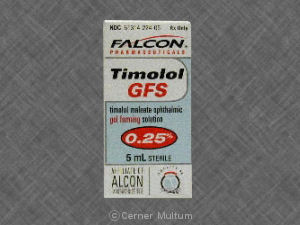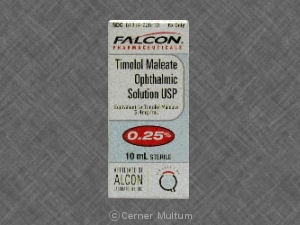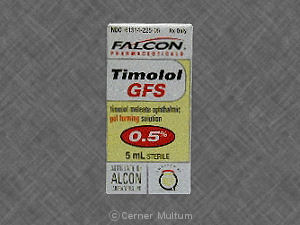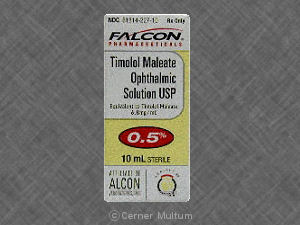What is the most important information I should know about timolol ophthalmic?
You should not use this medicine if you have asthma or severe COPD, or a serious heart condition (such as "sick sinus syndrome," 2nd or 3rd degree "AV block," severe heart failure, or very slow heartbeats).
Side effects may occur if this medicine is absorbed into your bloodstream. Call your doctor right away if you have: chest pain, trouble breathing, slow heartbeats, muscle weakness, numbness or coldness in your hands or feet, unusual mood or behavior changes, or severe dizziness.
What is timolol ophthalmic?
Timolol is a beta-blocker that also reduces pressure inside the eye.
Timolol ophthalmic (for the eyes) is used to treat open-angle glaucoma and other causes of high pressure inside the eye.
Timolol ophthalmic may also be used for purposes not listed in this medication guide.
What should I discuss with my healthcare provider before using timolol ophthalmic?
You should not use this medicine if you are allergic to timolol, or if you have:
- asthma or severe chronic obstructive pulmonary disease (COPD);
- certain serious heart conditions, especially "sick sinus syndrome" or 2nd or 3rd degree "AV block";
- severe heart failure; or
- slow heartbeats that have caused you to faint.
To make sure timolol ophthalmic is safe for you, tell your doctor if you have ever had:
- heart disease, a stroke, a blood clot, or circulation problems;
- breathing problems;
- diabetes;
- a thyroid disorder;
- narrow-angle glaucoma;
- allergies; or
- a muscle disorder such as myasthenia gravis.
It is not known whether this medicine will harm an unborn baby. Tell your doctor if you are pregnant or plan to become pregnant.
Timolol ophthalmic can pass into breast milk and may harm a nursing baby. You should not breast-feed while using this medicine.
Timolol ophthalmic is not approved for use by anyone younger than 2 years old.
How should I use timolol ophthalmic?
Follow all directions on your prescription label. Your doctor may occasionally change your dose. Do not use this medicine in larger or smaller amounts or for longer than recommended.
Do not use this medicine while wearing contact lenses. Timolol ophthalmic may contain a preservative that can discolor soft contact lenses. Wait at least 15 minutes after using this medicine before putting in your contact lenses.
Wash your hands before using the eye drops.
To apply the eye drops:
- Tilt your head back slightly and pull down your lower eyelid to create a small pocket. Hold the dropper above the eye with the tip down. Look up and away from the dropper and squeeze out a drop.
- Close your eyes for 2 or 3 minutes with your head tipped down, without blinking or squinting. Gently press your finger to the inside corner of the eye for about 1 minute, to keep the liquid from draining into your tear duct.
- Use only the number of drops your doctor has prescribed. If you use more than one drop, wait about 5 minutes between drops.
- Wait at least 10 minutes before using any other eye drops your doctor has prescribed.
Do not touch the tip of the eye dropper or place it directly on your eye. A contaminated dropper can infect your eye, which could lead to serious vision problems.
Do not use the eye drops if the liquid has changed colors or has particles in it. Call your pharmacist for new medicine.
It may take a few weeks before your symptoms improve. Keep using the medication as directed and tell your doctor if your symptoms do not improve after 4 weeks of treatment.
If you need surgery, including eye surgery, tell the surgeon ahead of time that you are using timolol ophthalmic. You may need to stop using the medicine for a short time.
You should not stop using this medicine suddenly. Follow your doctor's instructions about tapering your dose.
Store at room temperature away from moisture, heat, and light. Do not freeze. Keep the bottle tightly closed when not in use. Keep each single-use ampule inside its foil pouch until you are ready to use your dose.
A single-use ampule is for one use only. Throw it away after one use, even if there is still medicine left inside.
What happens if I miss a dose?
Use the missed dose as soon as you remember. Skip the missed dose if it is almost time for your next scheduled dose. Do not use extra medicine to make up the missed dose.
What happens if I overdose?
Seek emergency medical attention or call the Poison Help line at 1-800-222-1222.
Overdose symptoms may include dizziness, headache, slow heartbeats, and trouble breathing.
What should I avoid while using timolol ophthalmic?
Timolol ophthalmic can cause blurred vision. Be careful if you drive or do anything that requires you to be able to see clearly.
You may need to use other glaucoma medications in addition to timolol ophthalmic. Do not use other eye medications unless your doctor tells you to.
What are the possible side effects of timolol ophthalmic?
Get emergency medical help if you have signs of an allergic reaction: hives; difficult breathing; swelling of your face, lips, tongue, or throat.
Although the risk of serious side effects is low when timolol is used in the eyes, side effects can occur if the medicine is absorbed into your bloodstream. Call your doctor right away if you have:
- wheezing, chest pain, trouble breathing, slow heartbeats;
- a light-headed feeling, like you might pass out;
- muscle weakness;
- depressed mood, confusion, hallucinations, unusual thoughts or behavior; or
- numbness or cold feeling in your hands and feet.
Also call your doctor if you have:
- severe stinging or burning after using the eye drops:
- eye swelling, redness, severe discomfort, crusting or drainage (may be signs of infection); or
- blurred vision, tunnel vision, eye pain, or seeing halos around lights.
Common side effects may include:
- burning or stinging in your eye;
- dry eyes, itching;
- feeling like something is in your eye;
- red or puffy eyelids; or
- headache.
This is not a complete list of side effects and others may occur. Tell your doctor about any unusual or bothersome side effect. You may report side effects to FDA at 1-800-FDA-1088.
What other drugs will affect timolol ophthalmic?
Tell your doctor about all your current medicines and any you start or stop using, especially:
-
any other beta-blocker eye medication --betaxolol, carteolol, levobunolol, or metipranolol;
-
any other beta-blocker heart or blood pressure medicine --atenolol, bisoprolol, carvedilol, labetalol, metoprolol, nadolol, propranolol, sotalol, and others; or
-
other heart or blood pressure medications --amiodarone, clonidine, digoxin, diltiazem, disopyramide, nicardipine, nifedipine, reserpine, verapamil, and others.
This list is not complete. Other drugs may interact with timolol ophthalmic, including prescription and over-the-counter medicines, vitamins, and herbal products. Not all possible interactions are listed in this medication guide.
Where can I get more information?
Your pharmacist can provide more information about timolol ophthalmic.
Remember, keep this and all other medicines out of the reach of children, never share your medicines with others, and use this medication only for the indication prescribed.
Every effort has been made to ensure that the information provided by Cerner Multum, Inc. ('Multum') is accurate, up-to-date, and complete, but no guarantee is made to that effect. Drug information contained herein may be time sensitive. Multum information has been compiled for use by healthcare practitioners and consumers in the United States and therefore Multum does not warrant that uses outside of the United States are appropriate, unless specifically indicated otherwise. Multum's drug information does not endorse drugs, diagnose patients or recommend therapy. Multum's drug information is an informational resource designed to assist licensed healthcare practitioners in caring for their patients and/or to serve consumers viewing this service as a supplement to, and not a substitute for, the expertise, skill, knowledge and judgment of healthcare practitioners. The absence of a warning for a given drug or drug combination in no way should be construed to indicate that the drug or drug combination is safe, effective or appropriate for any given patient. Multum does not assume any responsibility for any aspect of healthcare administered with the aid of information Multum provides. The information contained herein is not intended to cover all possible uses, directions, precautions, warnings, drug interactions, allergic reactions, or adverse effects. If you have questions about the drugs you are taking, check with your doctor, nurse or pharmacist.
Copyright 1996-2018 Cerner Multum, Inc. Version: 8.01. Revision date: 7/26/2017.



